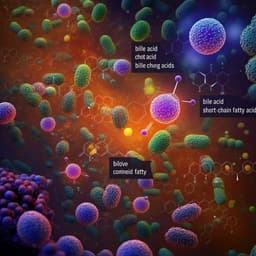
Food Science and Technology
Obesity, but not high-fat diet, is associated with bone loss that is reversed via CD4+CD25+Foxp3+ Tregs-mediated gut microbiome of non-obese mice
W. Song, Q. Sheng, et al.
This fascinating study conducted by Wei Song and colleagues reveals the critical link between high-fat diet-induced obesity and bone loss in mice, while highlighting the protective role of a healthy gut microbiome that supports bone health through short-chain fatty acid production. A remarkable fecal microbiota transplantation reversed bone loss, showcasing the gut's power in maintaining skeletal integrity.
~3 min • Beginner • English
Introduction
Osteoporosis is the most prevalent chronic metabolic bone disease, characterized by decreased bone mass, microarchitectural deterioration, and increased fracture risk. Bone loss arises from an imbalance in remodeling. While preventive methods exist, many have barriers such as the need for exercise adherence or side effects and costs of pharmacologic therapies, motivating interest in dietary interventions as safer, easier strategies to improve bone health. High-fat diets (HFDs) are common globally and can lead to obesity, metabolic abnormalities, and bone resorption, increasing fracture risk. However, HFD does not invariably cause obesity, and the effects of HFD in non-obese individuals on bone health are understudied. This raises the key question: does bone loss stem from HFD-induced obesity or from the HFD itself? The gut microbiota influences host physiology, including bone remodeling, via immune, endocrine, and metabolic pathways. Short-chain fatty acids (SCFAs), produced by bacterial fermentation, regulate osteoclastogenesis and bone homeostasis and modulate colonic regulatory T cells (Tregs) via HDAC inhibition and GPCR signaling. Tregs can ameliorate bone loss in disease models, but their role in HFD-induced obesity-related bone loss is unclear. The present study tests whether HFD-induced obesity versus HFD alone drives bone loss, and investigates the gut microbiome–SCFA–Treg axis as a mechanism. The authors show that HFD-induced obesity leads to gut dysbiosis and bone loss, while HFD-fed non-obese (NO) mice maintain healthy bone properties, with benefits mediated by SCFAs and transferable via fecal microbiota transplantation (FMT).
Literature Review
Methodology
- Animal model: Male SPF BALB/c mice (5 weeks old) were acclimated and fed either chow diet (CD; 10% kcal fat) or high-fat diet (HFD; 45% kcal fat) for 10 weeks. Based on body weight relative to CD controls, mice fed HFD were stratified into HFD-induced obesity (HIO; >20% heavier than CD) and non-obese (NO; similar to CD range). HIO and NO groups continued HFD for another 10 weeks.
- SCFA intervention: During the second 10-week period, subsets of HFD mice received daily gavage of an SCFA mix (67.5 mM acetate, 40 mM butyrate, 25.9 mM propionate; 300 mmol/L) or saline.
- Fecal microbiota transplantation (FMT): Fresh feces from donor CD, HIO, or NO mice were collected daily, suspended (100 mg/mL in sterile saline), lightly centrifuged; supernatant was gavaged daily into recipient mice for 10 weeks (CD+FMT, HIO+FMT, NO+FMT), while maintaining their respective diets.
- Bone biomechanical testing: Femoral three-point bending assessed maximum flexural stress, maximum load, and elastic (Young’s) modulus (Instron 5569; span 6 mm; 1 mm/min).
- Micro-computed tomography (µ-CT): Fixed right femurs scanned (SCANCO µ-CT 100; 70 kV, 200 µA) to quantify density, BV, TV, BV/TV, Tb.N, Tb.Th, Tb.Sp, BS, and BS/BV; tibial trabecular structures were also imaged.
- Histology and immunohistochemistry: Joint/femur sections stained with H&E and Masson trichrome; immunostaining for OPG and RANKL in bone, and for Foxp3, IL-10, and TGF-β1 in colon; imaging by fluorescence/brightfield microscopy; blinded evaluation.
- Serum biochemistry: Triglycerides (TG), total cholesterol (TC), alkaline phosphatase (ALP), TRAP, and RANKL quantified using commercial kits/ELISA.
- Gene expression (qRT-PCR): RNA from colon, small intestine, spleen, lymph nodes, and bone tissue analyzed for Ffar2, Foxp3, IL-10, TGF-β1, Hdac2, Hdac7, P300, Crebbp, Pcaf, Claudin1, Occludin, Rankl, Opg, Trap, Ctsk.
- Flow cytometry: Mesenteric lymph node single-cell suspensions stained for CD4, CD25, and intracellular Foxp3 to quantify CD4+CD25+Foxp3+ Tregs and CD4+CD25+ T cells; additional CD3/CD4/CD8 profiling.
- Ex vivo osteoclastogenesis assay: T cells isolated from spleens of CD, HIO, or NO mice were co-cultured with RAW264.7 macrophages for up to 10 days; TRAP staining quantified osteoclast differentiation; supernatants assayed for IL-10 and TGF-β1; RAW264.7 expression of Rankl, Opg, Trap analyzed.
- Microbiome profiling: Fecal DNA extracted; 16S rRNA gene V3–V4 amplicons sequenced; OTU clustering and taxonomic assignment; alpha diversity indices (OTU count, PD_Whole_tree, Chao1, ACE); Firmicutes/Bacteroidetes ratio; differential abundance at phylum/family/genus levels; PCA for beta diversity.
- Fecal metabolomics: LC–MS-based untargeted profiling (UPLC with ACQUITY UPLC T3; TripleTOF 5600+; positive/negative modes); feature detection, annotation via KEGG/HMDB; PLS-DA and VIP; pathway enrichment analyses.
- Targeted SCFA quantification: Derivatized SCFAs measured by Thermo Q Exactive Focus; quantified acetate, propionate, butyrate, isobutyrate, dimethylbutyric acid, n-valeric acid, isovaleric acid, caproic acid.
- Statistics: One-way or two-way ANOVA as appropriate with SEM reporting; Pearson correlations for associations between taxa/SCFAs and bone/immune parameters.
Key Findings
- HFD-induced obesity (HIO), but not HFD alone, caused bone loss. HIO mice showed decreased trabecular BV/TV, reduced trabecular number (Tb.N), increased trabecular separation (Tb.Sp), and higher structure model index (SMI), whereas HFD-fed non-obese (NO) mice maintained or improved these parameters relative to CD controls.
- Biomechanics: NO mice exhibited a trend toward increased tibial Young’s modulus (greater tenacity) compared with HIO; maximum bending stress/load were not significantly changed. Cortical bone mean density tended to be higher in NO vs HIO without changes in cortical thickness.
- RANKL/OPG axis: NO tibias had higher OPG and lower RANKL expression than HIO, indicating reduced osteoclastogenesis.
- Gut microbiome: NO microbiota clustered closer to CD than HIO by PCA (PC1 explaining 59.77%). Alpha diversity metrics (OTU count, PD_Whole_tree, Chao1, ACE) were higher in NO vs HIO. Firmicutes/Bacteroidetes ratio was lower in NO. HIO was enriched in Erysipelotrichaceae, Enterococcaceae, Peptostreptococcaceae, Corynebacteriaceae, Saccharimonadaceae, Aerococcaceae, Eggerthellaceae; NO was enriched in SCFA-producing/obesity-negative taxa including Akkermansiaceae, Prevotellaceae, Ruminococcaceae, Lachnospiraceae, Bacteroidaceae, Enterobacteriaceae, Rikenellaceae, Muribaculaceae.
- SCFAs: NO mice had higher fecal acetate and butyrate (propionate trended higher) than HIO. Multiple SCFA-producing genera positively correlated with SCFA levels; Lachnospiraceae_UCG-006 negatively correlated with several SCFAs and was lower in NO.
- Fecal metabolomics: Fifty differential metabolites distinguished NO vs HIO. NO showed altered pathways including phenylalanine, tyrosine, tryptophan biosynthesis and central carbon metabolism. HIO displayed increased tryptophan catabolites (e.g., 6-hydroxymelatonin, 3-methylindole pyruvate) and tyrosine-related metabolites, and higher purines (xanthine, hypoxanthine, 5-hydroxyisourate), which correlated negatively with bone quality and positively with Tb.Sp.
- SCFA treatment: Gavage of an SCFA mix to HIO mice improved femoral head trabecular microarchitecture and cartilage collagen organization, increased bone strength (three-point bending), elevated fecal acetate/propionate, and upregulated Ffar2 expression in colon, small intestine, and spleen.
- FMT: Transplanting NO microbiota into HIO mice increased alpha diversity and Akkermansiaceae abundance, upregulated Ffar2 in colon and lymph nodes (positively correlated with Candidatus_Saccharimonas, Lactobacillus, Lachnospiraceae_UCG-006, Ruminococcaceae_UCG-014, Ruminococcaceae_NK4A214_group), and improved bone microarchitecture (↑BV, Tb.Th, Tb.N; ↓Tb.Sp) with decreased osteoclast gene expression (Trap, Ctsk) and reduced serum RANKL.
- Tregs: NO mice had significantly higher percentages of CD4+CD25+Foxp3+ Tregs and CD4+CD25+ T cells than HIO. Treg and CD4+CD25+ T cell levels positively correlated with Young’s modulus, BV/TV, and SMI, and negatively with Tb.Sp. SCFA gavage increased Foxp3 and IL-10 mRNA (but not TGF-β1) in colon/small intestine.
- Ex vivo co-culture: T cells from NO mice inhibited RAW264.7 osteoclast differentiation (reduced multinucleated TRAP+ cells), downregulated Rankl and Trap, and decreased Rankl/Opg ratio; supernatants had higher IL-10 (not TGF-β1).
- Post-FMT immune/epigenetic changes: NO→HIO FMT increased Foxp3+ Tregs and IL-10 in colon; Foxp3 mRNA increased in lymph nodes and colon; IL-10 increased in lymph nodes. Hdac2 and Hdac7 were downregulated in colon and spleen; P300, Crebbp, and Pcaf upregulated in colon. Claudin1 expression increased, indicating improved intestinal barrier.
Discussion
The study disentangles effects of diet composition from obesity status on bone health, showing that HFD per se does not necessarily impair bone properties; rather, HFD-induced obesity is the key driver of bone loss. NO mice on long-term HFD maintained or improved trabecular architecture and bone strength, contrasting with HIO mice. These differences are linked to gut microbiome composition: NO mice harbor diverse, SCFA-producing communities that elevate acetate and butyrate, while HIO mice exhibit dysbiosis with taxa associated with metabolic and inflammatory disorders and altered purine/tryptophan metabolism. Mechanistically, microbiota-derived SCFAs signal via Ffar2 and epigenetic modulation (HDAC inhibition; increased histone acetyltransferases such as P300/CREBBP/PCAF) to enhance Foxp3 stability, expanding Tregs and IL-10 production. This immunomodulation suppresses osteoclastogenesis (reduced RANKL/OPG ratio, decreased Trap/Ctsk), thereby preserving bone mass and microarchitecture. Causality is supported by SCFA supplementation and FMT from NO donors, which recapitulate the bone-protective, immunologic, and gene expression changes in obese recipients. These findings position the gut microbiome–SCFA–Treg axis as a central mediator of the gut–bone connection, explaining why some individuals on HFD remain non-obese with healthier bones and suggesting that microbial composition, not dietary fat content alone, determines bone outcomes under HFD.
Conclusion
HFD-induced obesity—rather than HFD itself—drives bone fragility and loss. Non-obese mice fed HFD retain bone strength and microstructural integrity through a gut microbiome enriched in SCFA-producing taxa. SCFAs act via Ffar2 activation and HDAC inhibition, promoting Treg (Foxp3+, IL-10+) expansion and suppressing osteoclastogenesis. These effects are transferable by FMT and can be mimicked by SCFA supplementation. The work highlights the gut microbiome–SCFA–Treg axis as a therapeutic target to prevent or reverse obesity-associated bone loss and suggests that personalized nutrition strategies should consider an individual’s microbiome rather than fat content alone. Future research should delineate specific microbial strains/metabolites responsible, explore sex and strain differences, and evaluate translational potential in humans.
Limitations
Related Publications
Explore these studies to deepen your understanding of the subject.







